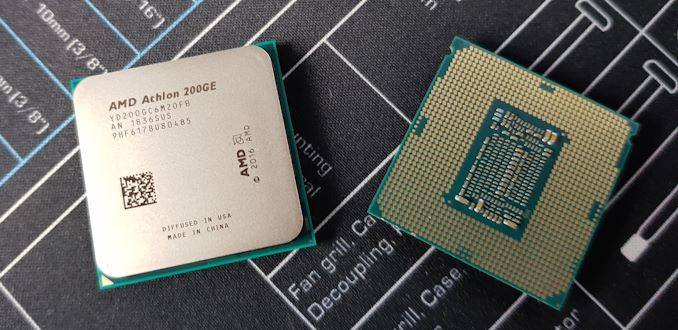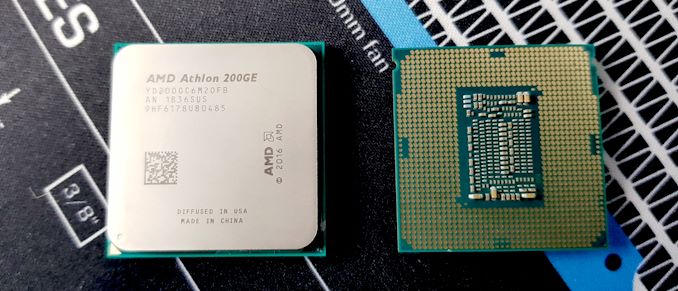The $60 CPU Question: AMD Athlon 200GE or Intel Pentium Gold G5400? A Review
by Ian Cutress on January 14, 2019 8:00 AM EST
In the course of our reviews, when we get a chance to get hands on with random processors, we run our test suite and add the data to our database. Sometimes that doesn’t materialize directly into a review, but at least we have the data. Two very similar CPUs have come across my desk recently: AMD’s dual core Athlon 200GE, and Intel’s Pentium G5400. Both chips round to the $60 mark, have some form of integrated graphics, and are aimed at budget systems.
This is going to be fun
One of the perennial issues with modern technology review cycles is that there’s a lot of focus on the high-end parts. These are the ones that the manufacturers sample: they have the highest margins, but are also the halo products: if they sit atop of the standings, then the hope is that that influence will trickle down into the rest of the product range, typically the high-volume parts. There is also the added benefit that more people want to hear about the best of the best. It’s a reason why there are so many Ferrari and Aston Martin ‘WOW’ pieces in written and video media.
Normally this would make sampling very difficult. If we were reviewing cars, anyway. The two chips in today’s analysis, the Intel Pentium Gold G5400 and the AMD Athlon 200GE, cost around $60 apiece, which I forked out for personally as I was never expecting to be sampled. (AMD asked if I wanted a 200GE sample two days after my retail unit arrived, go figure. I sent that on to Gavin for his 7-year old’s new gaming system.)
| AMD vs Intel at ~$60 | ||
| AMD Athlon 200GE |
Intel Pentium Gold G5400 |
|
| Cores / Threads | 2 / 4 | 2 / 4 |
| Microarchitecture | Zen | Coffee Lake |
| Motherboards | X470, X370, B450 B350, A320, A300 |
Z390, Z370, Q370 H370, B360, H310 |
| CPU Frequency | 3.2 GHz | 3.7 GHz |
| L2 Cache | 512 KB/core | 256 KB/core |
| L3 Cache | 2 MB / core | 2 MB / core |
| Integrated Graphics | Vega 3 192 SPs |
UHD 610 12 EUs (96 ALUs) |
| DDR4 Support | DDR4-2933 | DDR4-2666 |
| GPU Frequency | Up to 1000 MHz | 350-1050 MHz |
| TDP | 35 W | 54 W (2-core die version) 58 W (4-core die version)* |
| Price | $55 (SRP) | $64 (1k/u) |
| * Intel harvests both 2+2 and 4+2 dies to make G5400 parts. It's impossible to know which one you have without removing the lid and measuring the die area. | ||
When we stack up the two processors side by side, it gets interesting. Both are dual core, quad thread parts. The Intel processor has the frequency advantage, running at 3.7 GHz compared to the 3.2 GHz of AMD, but the AMD has beefier Vega 3 integrated graphics compared to the UHD 610 (GT1) graphics of the Intel chip. One sore point might be the TDP, where the AMD chip has a rating of 35W and the Intel chip is rated at 58W, however as we’ll see in the review, neither of them come close to those values.
Tackling the budget end of the market is fun. I’ve been a long-time advocate for budget builders to build a system piece-by-piece, getting one high-end part at a time rather than smearing a budget across several average parts at once. Under this philosophy, these processors could very well be the start of one of those builds, only costing an average of $60 MSRP. Note that under this philosophy, you might end up with that big graphics card before a processor that can power it. We’re covering those benchmarks as well.
Before you click further, place your bets on who you think will win: the Intel Pentium Gold G5400, or the AMD Athlon 200GE?
Latest News: While neither processor is officially overclockable, since we tested for this article it was recently reported that MSI motherboards with certain BIOS versions will allow users to overclock the 200GE to ~3.9 GHz. I've asked Gavin to contribute, and he managed a nice 3.9 GHz over the 3.2 GHz base clock. Head over to page 21 for the details.
Pages In This Review
- Analysis and Competition
- Test Bed and Setup
- 2018 and 2019 Benchmark Suite
- CPU Performance: System Tests
- CPU Performance: Rendering Tests
- CPU Performance: Office Tests
- CPU Performance: Encoding Tests
- CPU Performance: Legacy Tests
- Gaming: Integrated Graphics
- Gaming: World of Tanks enCore
- Gaming: Final Fantasy XV
- Gaming: Shadow of War
- Gaming: Civilization 6
- Gaming: Ashes Classic
- Gaming: Strange Brigade
- Gaming: Grand Theft Auto V
- Gaming: Far Cry 5
- Gaming: Shadow of the Tomb Raider
- Gaming: F1 2018
- Power Consumption
- Overclocking
- Conclusions and Final Words











95 Comments
View All Comments
Irata - Tuesday, January 15, 2019 - link
Curious - which Retailer ?Valantar - Tuesday, January 15, 2019 - link
The difference in Norway is slightly larger, with 599NOK for the 200GE vs. 729 for the G5400 - but it's not in stock anywhere, so prices may be fictitious (or there's no supply at all). 200GE supply seems plentiful.andrewaggb - Tuesday, January 15, 2019 - link
I liked the article. I was interested in the 200GE's performance for some headless budget builds and now I know where it sits.I wouldn't use either of these chips on even a budget gaming build. Get a 2200g or i3 8100+ for gaming.
darb - Wednesday, January 16, 2019 - link
On page 3, is "Uses might ask why we are not running Windows 10 x64 RS4, the latest major update" supposed to be "Users might ask why..."?Stuka87 - Wednesday, January 16, 2019 - link
Under gaming with the World of Tanks results, it says GTX1080, but then also has an IGP column, and the IGP column is higher than everything else? Also, Encore engine was released last year, and WoT has been using it since April. So it is no longer "unreleased".GreenReaper - Thursday, January 17, 2019 - link
I think the idea is that it is "IGP"-level *settings*, run on the video card. It's a tad confusing, I agree.just4U - Wednesday, January 16, 2019 - link
I always find it fun to compare budget processors to yesteryear's high end to see where you land up.. It almost looks like this is in the range of a low end 4000 series i5 and a bit better than it's i3 variants. Hmm.. 2 cores though ugh. I'd probably want at least 4.GreenReaper - Thursday, January 17, 2019 - link
It's worth if you can possibly afford it. About the only other situation I see it making sense *not* to is if power or cooling is a major consideration (especially if hyperthreading works for you). My server is just fine on two cores, and that reduces its power and cooling requirements, which have a 35W limit.Death666Angel - Wednesday, January 16, 2019 - link
I sent you a tweet about the lables in the GTX1080 section and then realised I misread it. Deleted the tweet. Oh well. Good conclusion overall, very fair. Aligns perfectly with what I would do.Unfortunately, here (Germany) as well, the Intel CPUs are way overpriced. For a G5400 I can get a Ryzen 3 2200G. So it all kinda falls apart because of the weird CPU shortage.
Manch - Friday, January 18, 2019 - link
Would this be good for a NAS?